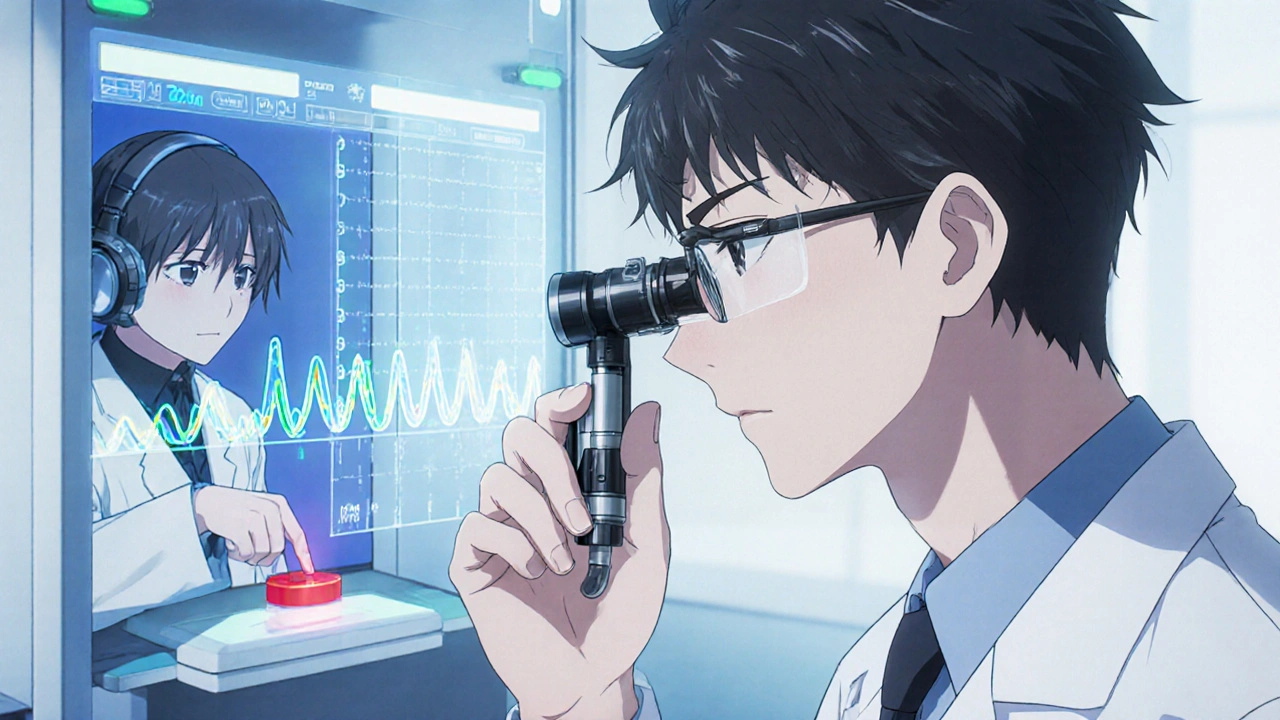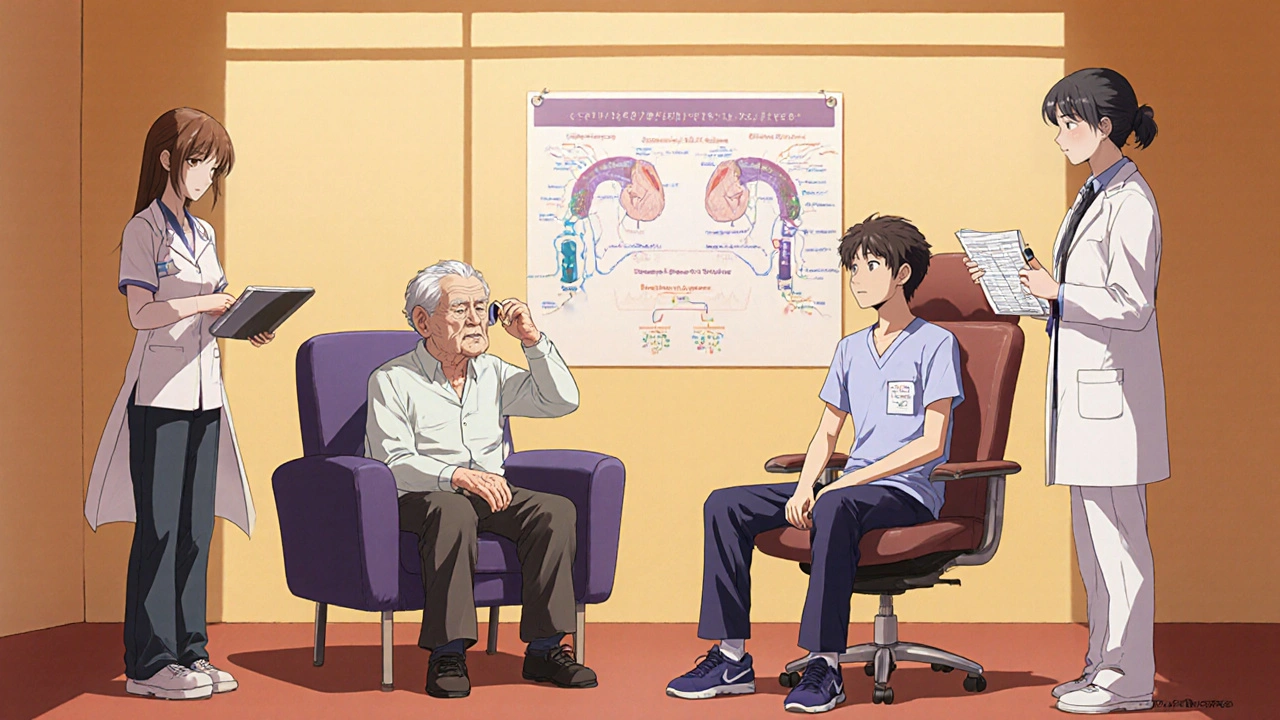Hearing Loss Assessment Tool
This interactive tool helps you understand common hearing loss patterns based on standard audiometric testing. Enter your hearing thresholds for key frequencies to see your results.
Enter Your Hearing Test Results
Enter your hearing thresholds at standard frequencies (in decibels). Typical normal hearing is 0-25 dB.
When you notice sounds fading or conversations slipping away, the first question is usually “who can help?” Most people think of doctors, but the specialist who spends the day listening to your ears is the Audiologist a health‑care professional trained to assess, diagnose, and manage hearing loss and related balance disorders. Understanding what an audiologist actually does, how they differ from other clinicians, and what to expect during a visit can turn a confusing situation into a clear path toward better hearing.
Who Is an Audiologist?
An audiologist is not just a technician who hands you a hearing aid. They hold a master’s degree (M.A., M.S., or Au.D.) in audiology, complete a clinical fellowship, and must be licensed in the state where they practice. In the United States, most audiologists are also certified by the American Speech‑Language‑Hearing Association (ASHA) or the American Board of Audiology. Their training covers anatomy of the ear, acoustics, signal processing, and the neuro‑physiology of hearing.
Training and Certification - What Sets Them Apart
- Four‑year undergraduate degree in a science‑related field.
- Graduate program (typically two years) focusing on diagnostic testing, hearing‑aid technology, and vestibular assessment.
- Clinical practicum of at least 1,200 supervised hours.
- State licensure exam + optional national certification (e.g., CCC‑A).
This rigorous path ensures an audiologist can interpret complex test results and tailor treatment plans to each patient’s lifestyle.
How Audiologists Diagnose Hearing Loss
The diagnostic journey usually starts with a series of objective and subjective tests. Below is the typical sequence:
- Case History - The audiologist asks about noise exposure, family history, medical conditions, and the specific listening problems you face.
- Otoscopy - A visual inspection of the ear canal and eardrum using a handheld otoscope to rule out blockages or infections.
- Pure‑Tone Audiometry - You wear headphones and indicate when you hear beeps at various frequencies (250 Hz to 8 kHz). The results produce an audiogram that maps the softest sounds you can detect.
- Speech Audiometry - Measures how well you understand spoken words at different volume levels, providing insight into real‑world communication difficulty.
- Tympanometry - A small probe changes air pressure in the ear canal to assess middle‑ear function (e.g., fluid, eustachian tube problems).
- Otoacoustic Emissions (OAEs) - A non‑invasive test that checks outer‑hair‑cell activity in the cochlea, useful for newborn screening and detecting early damage.
- Auditory Brainstem Response (ABR) - Electrodes record neural activity in response to clicks or tone bursts, helping differentiate sensory loss from neural pathologies.
By combining these data points, the audiologist creates a comprehensive picture of where the hearing system is breaking down.

From Diagnosis to Treatment - What Audiologists Provide
Once the type and degree of loss are clear, the audiologist moves into the treatment phase. Their toolkit includes:
- Hearing Aids - Digital devices that amplify sound, programmed to match your audiogram and listening environments.
- Assistive Listening Devices (ALDs) - FM systems, looped hearing‑assist systems, and smartphone‑based apps that boost signal‑to‑noise ratios in specific situations.
- Cochlear Implant Referral - For severe to profound sensorineural loss, the audiologist conducts candidacy testing and coordinates with an ENT surgeon for implantation.
- Aural Rehabilitation - Counseling on communication strategies, auditory training exercises, and speech‑reading techniques.
- Balance Assessment - Vestibular testing (e.g., videonystagmography) when dizziness accompanies hearing loss.
Each recommendation is personalized. For example, a senior who enjoys theater will receive a behind‑the‑ear (BTE) hearing aid with directional microphones, while a teenager into sports may get a receiver‑in‑the‑ear (RITE) model with a robust sweat‑proof design.
Collaboration with Other Professionals
Audiologists rarely work in isolation. They regularly coordinate with:
| Aspect | Audiologist | ENT Specialist (OTOLARYNGOLOGIST) | Speech‑Language Pathologist |
|---|---|---|---|
| Primary Focus | Hearing & balance assessment, device fitting | Medical/surgical management of ear, nose, throat | Speech, language, and swallowing therapy |
| Typical Procedures | Audiometry, hearing‑aid programming | Ear surgery, medication prescription | Auditory training, voice therapy |
| When to See | Unexplained hearing loss, device needs | Ear infections, vertigo, facial nerve issues | Post‑stroke language deficits, pediatric speech delays |
These collaborations ensure you receive both medical treatment (if needed) and the appropriate auditory support.

What to Expect at Your First Audiology Appointment
- Bring any prior test results, medication lists, and a list of specific listening challenges.
- The audiologist will perform a quick otoscopic inspection and ask about your hearing history.
- Expect a series of hearing tests lasting about 30‑45 minutes. The process is painless; you simply press a button when you hear a tone.
- After testing, the audiologist will review the audiogram with you, explain the type of loss (sensorineural, conductive, mixed), and discuss treatment options.
- If hearing aids are recommended, you’ll receive a trial device, counseling on care, and a follow‑up schedule.
Most clinics schedule a second appointment within 2-4 weeks to fine‑tune devices and address any questions.
Insurance, Costs, and Access
Understanding the financial side can be as daunting as the medical side. Here are some practical tips:
- Medicare Advantage plans often cover diagnostic testing and a portion of hearing‑aid costs, but Original Medicare does not.
- Private insurers may reimburse up to 80 % of the cost for a hearing aid after a documented medical necessity.
- Many audiology clinics offer financing plans (e.g., $0‑down, 12‑month installments) to spread out the expense.
- Some state Medicaid programs now include pediatric hearing‑aid coverage; check your local guidelines.
- Ask the audiologist for an itemized estimate before committing. This makes it easier to appeal to insurance or explore alternative funding.
Being proactive about paperwork saves weeks of back‑and‑forth.
Key Takeaways
- An audiologist is a licensed specialist with graduate‑level training in hearing and balance.
- Diagnosis involves a mix of visual inspection, pure‑tone audiometry, speech testing, and objective measures like OAEs.
- Treatment ranges from custom‑programmed hearing aids to referrals for cochlear implants and balance therapy.
- Collaboration with ENT doctors and speech‑language pathologists ensures comprehensive care.
- Prepare for appointments, know your insurance limits, and use financing options when needed.
When should I schedule an appointment with an audiologist?
If you notice difficulty understanding conversations, need to raise the TV volume unusually high, or experience ringing (tinnitus), book an appointment within a month. Early detection prevents further decline.
Do audiologists treat ear infections?
No. Ear infections are medical issues handled by an ENT specialist. However, an audiologist can assess any resulting hearing loss after the infection clears.
Can I get a hearing aid without a prescription?
In most U.S. states, a prescription from a licensed audiologist or physician is required for full insurance coverage. Over‑the‑counter personal sound amplifiers exist but are not true hearing aids and lack custom fitting.
What is the difference between a behind‑the‑ear (BTE) and a receiver‑in‑the‑ear (RITE) hearing aid?
BTE devices have the main processor behind the ear and a thin tube to the ear‑mold; they are robust and handle severe loss well. RITE models place the receiver inside the ear canal, offering a more discreet look but generally lower power output.
Are cochlear implants covered by insurance?
Most private insurers and Medicare Advantage plans cover cochlear implantation when a qualified audiologist determines candidacy. Coverage often includes the surgery, the device, and post‑operative programming.








Rachel Valderrama
October 21, 2025 AT 00:30Wow, you’ve just discovered the magical world of audiology, where every beep becomes a life‑changing epiphany.
Let’s celebrate the fact that you finally realized your ears aren’t just decorative accessories.
Audiologists spend years sipping coffee in sound‑proof rooms while mastering the art of turning dull tones into data.
They’ve earned master’s degrees, logged over a thousand supervised hours, and can still explain hearing thresholds without putting you to sleep.
First, they’ll ask you to recount every noisy concert you’ve survived, as if your teenage phase matters to the diagnostic algorithm.
Then they’ll peek inside your ear canal with an otoscope, pretending to be a tiny paparazzi for your eardrum.
Pure‑tone audiometry follows, where you’ll press a button whenever you hear a beep that sounds like a distant microwave.
Don’t forget speech audiometry-because apparently understanding a normal conversation is a rare luxury.
Tympanometry will test middle‑ear pressure, which is just a fancy way of saying they’ll puff air into your ear like a weird birthday surprise.
Otoacoustic emissions will check if your outer‑hair cells are still partying, while ABR will record brain waves like a DJ mixing beats.
All this data gets plotted on an audiogram that looks like a mountain range, reminding you that your hearing loss is officially a scenic view.
From there, the audiologist will suggest hearing aids that are basically tiny computers you can brag about on Instagram.
If you’re lucky, they’ll also mention assistive listening devices that make dinner tables less hostile.
And for the truly heroic cases, they’ll refer you to a surgeon for a cochlear implant-because who doesn’t want a brain‑controlled Bluetooth speaker?
So next time you wonder who can help, remember the audiologist: the unsung hero who turns your muffled world into a slightly louder soundtrack.
Brandy Eichberger
October 22, 2025 AT 18:20It’s genuinely fascinating how audiologists sit at the crossroads of science and art, meticulously interpreting those delicate audiograms while keeping a warm, friendly demeanor. Their collaboration with ENT specialists and speech‑language pathologists truly embodies a holistic approach to auditory health. When you walk into a clinic, you’ll notice the soothing environment-soft lighting, comfortable chairs, and a clear explanation of each test, which makes the whole process less intimidating. The depth of their training, from pure‑tone audiometry to sophisticated vestibular assessments, ensures that no stone is left unturned. I especially appreciate how they tailor hearing‑aid solutions to the individual’s lifestyle, whether that’s a tech‑savvy teen or a senior theater‑enthusiast. Their dedication to patient education, from communication strategies to device maintenance, is nothing short of commendable. In short, audiologists are the unsung maestros orchestrating the symphony of hearing restoration.
Eli Soler Caralt
October 24, 2025 AT 13:23oh wow the whole audiology thing is like a deep philosophical quest into the echo chambers of our existence 😏 i mean think about it – every beep is a tiny reminder that we’re all just trying to catch the faint whispers of meaning in a noisy universe 🌌 oae and abr are like the secret handshakes of the ear’s inner council, 🔑 unlocking the hidden songs of our DNA. sure the docs love their fancy degrees but at the end of the day, it’s all about listening to the silence between the notes, ya know? 🤓 🎧
Eryn Wells
October 26, 2025 AT 07:26👋 Hey everyone! Just wanted to add that audiologists aren’t just technical experts – they’re also cultural bridges. They help people from all backgrounds stay connected to their families, traditions, and community events. Whether you’re attending a choir rehearsal or catching up with grandparents over a video call, the right hearing care makes those moments possible. So let’s celebrate the inclusive side of audiology and the joy it brings to diverse lives! 🌍💙
Kathrynne Krause
October 28, 2025 AT 02:30Listen up, folks! 🎉 If you’ve ever felt like the world’s a muffled movie, it’s time to meet the audiology superheroes who turn static into crystal‑clear sound. They’ll dive deep into your ear’s backstage, pulling out the curtain on hidden issues with tools that sound like sci‑fi gadgets. From sleek hearing‑aid designs that sparkle like fireworks to balance tests that keep you steady on the dance floor, these pros blend tech wizardry with genuine heart. So grab that “listen‑up” attitude, book that appointment, and let the vibrant symphony of life blast through your ears!
Casey Cloud
October 29, 2025 AT 21:33Here’s the quick rundown you need: audiologists run the hearing tests pure‑tone speech and otoacoustic emissions they then match the results to a hearing‑aid setting they also check balance if you’re dizzy they coordinate with ENT docs for surgery or meds they give you a trial device and show you how to care for it follow‑up appointments fine‑tune the program and answer any questions you have
Devendra Tripathi
October 31, 2025 AT 16:36Look, I don’t care how fancy the audiology office looks or how many degrees they brag about. All that matters is whether they actually improve your hearing or just sell you overpriced gadgets. If you walk out with a device that barely makes a difference, you’ve been duped. Don’t let the glossy brochures blind you-demand solid results, not just marketing fluff.
Vivian Annastasia
November 2, 2025 AT 11:40Oh great, another reminder that hearing loss is a thing.